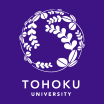海外留学体験談 【2025年入学前グローバル学習プログラム ハワイ大学マノア校】
2025年に実施したハワイ大学マノア校の体験談をご紹介します。
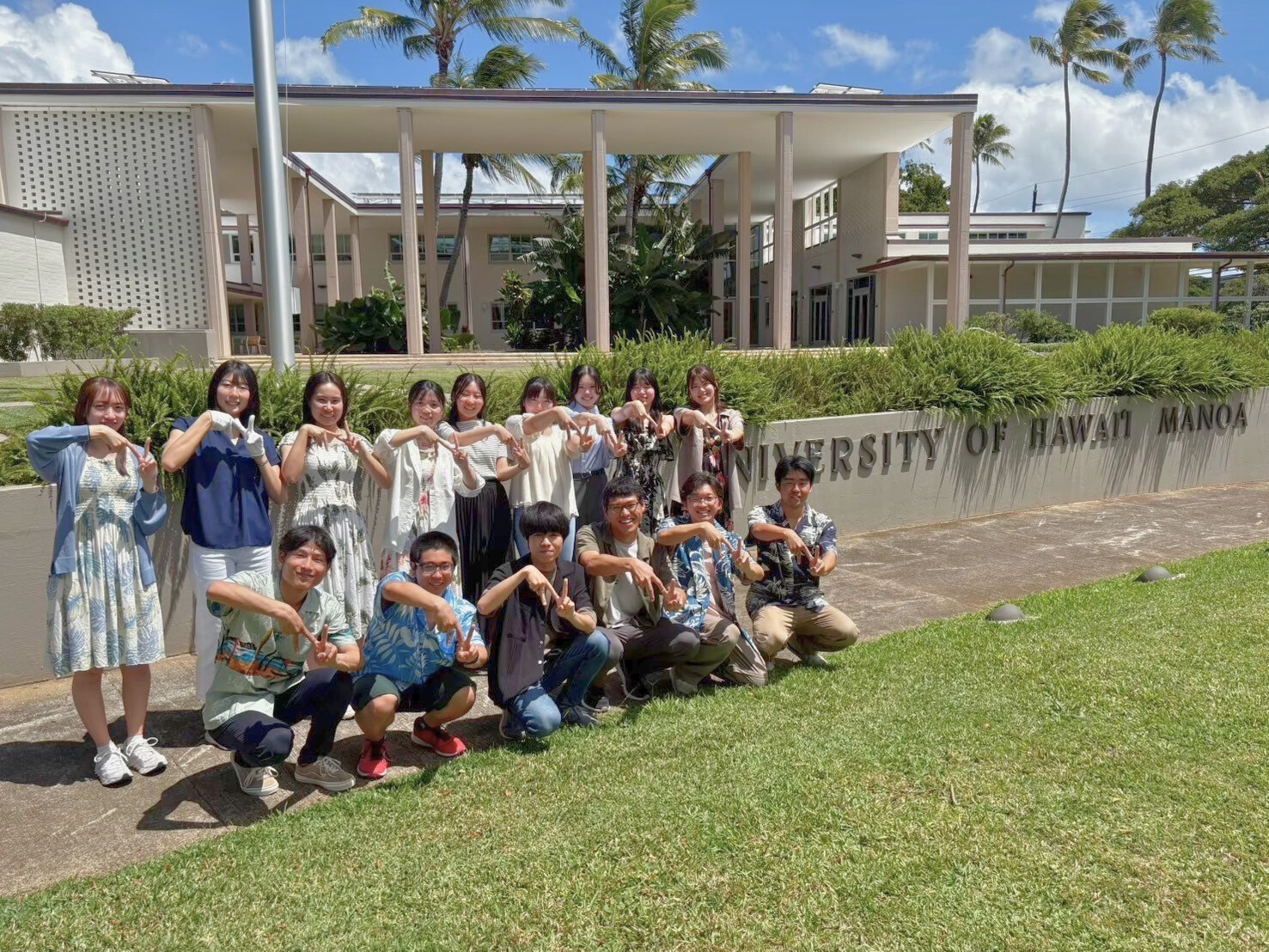
一歩踏み出して見えた世界:ハワイで感じた私の変化
黒田采音さん (教育学部)
参加プログラム:
2025年春入学前グローバル学習プログラム 環境・多⽂化コミュニケーションコース(アメリカ・ハワイ大学マノア校)
東北⼤学では、AO⼊試(総合型選抜)等で早めに⼊学が決まった⾼校⽣を対象に⼊学前グローバル学習プログラムが実施されています。本プログラムは、⼤学での学びやグローバル社会で求められる⼒を⼊学前に会得する機会となっています。今年は4コースが用意され、国内外合わせて4⼤学での研修を⾏いました。私は、その中の「環境・多⽂化コミュニケーションコース(ハワイコース)」に参加しました。ハワイコースは、オンライン事前研修(3回)、2025年3月9日から23日の2週間に及ぶハワイ⼤学マノア校(以下、UHマノア)での現地研修、そして帰国後の事後研修・成果報告会で構成されています。
ところで皆さんは、「ハワイ」と聞いて何を思い浮かべますか?美しい⾃然や美味しい食べ物など、リゾート地としてのイメージが強いかもしれません。そして、そんなハワイで送った日々は、きっとゆったりしたものだったのでは…と想像したのではないでしょうか。果たして、その想像は正しかったのか?ぜひ、私の体験談を通して確かめてみてください。読み終わる頃には、きっとあなたのイメージが変わっているかもしれません…。
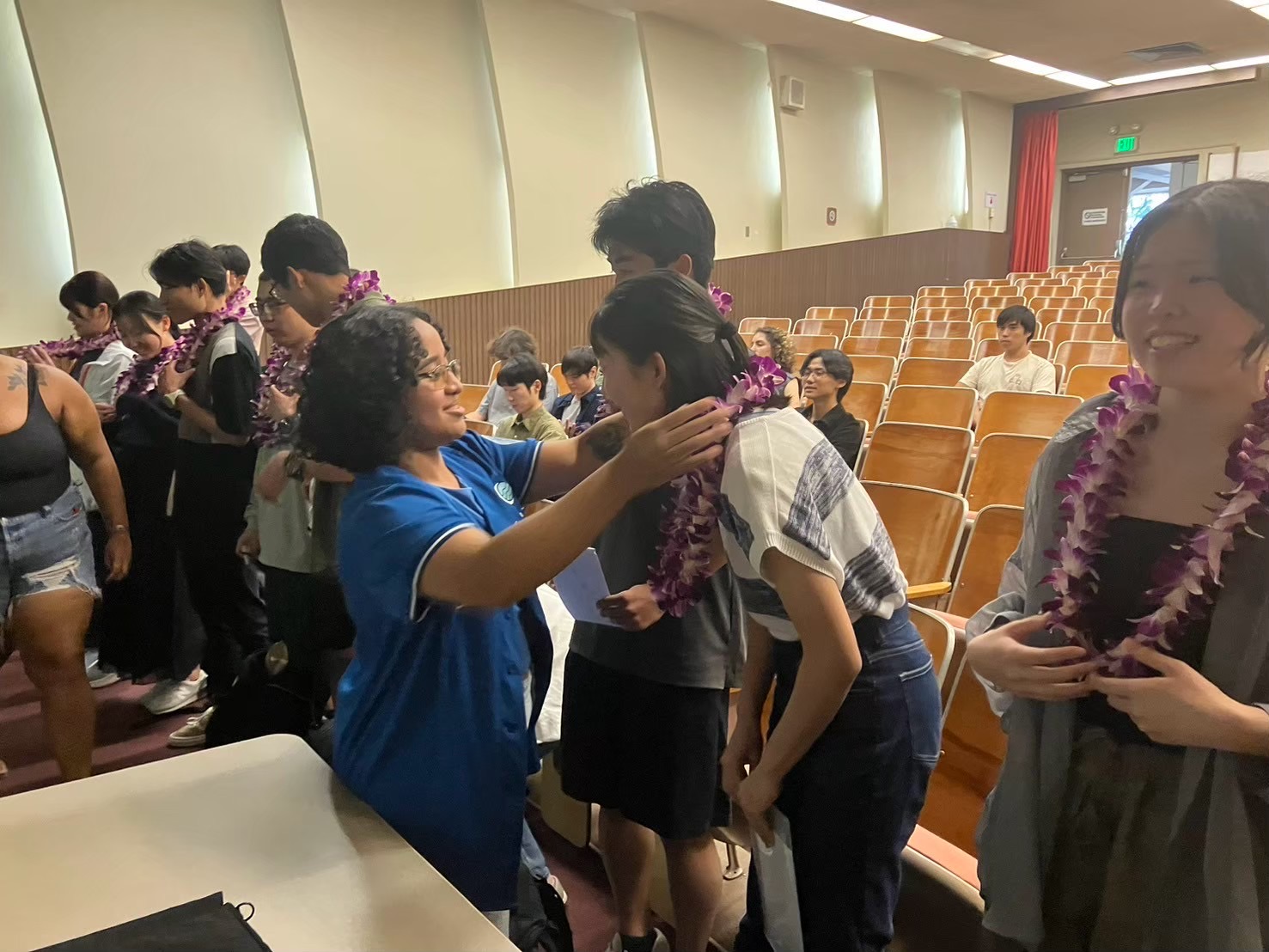
現地研修の一幕。現地学生に美しいレイでお出迎えしてもらった。
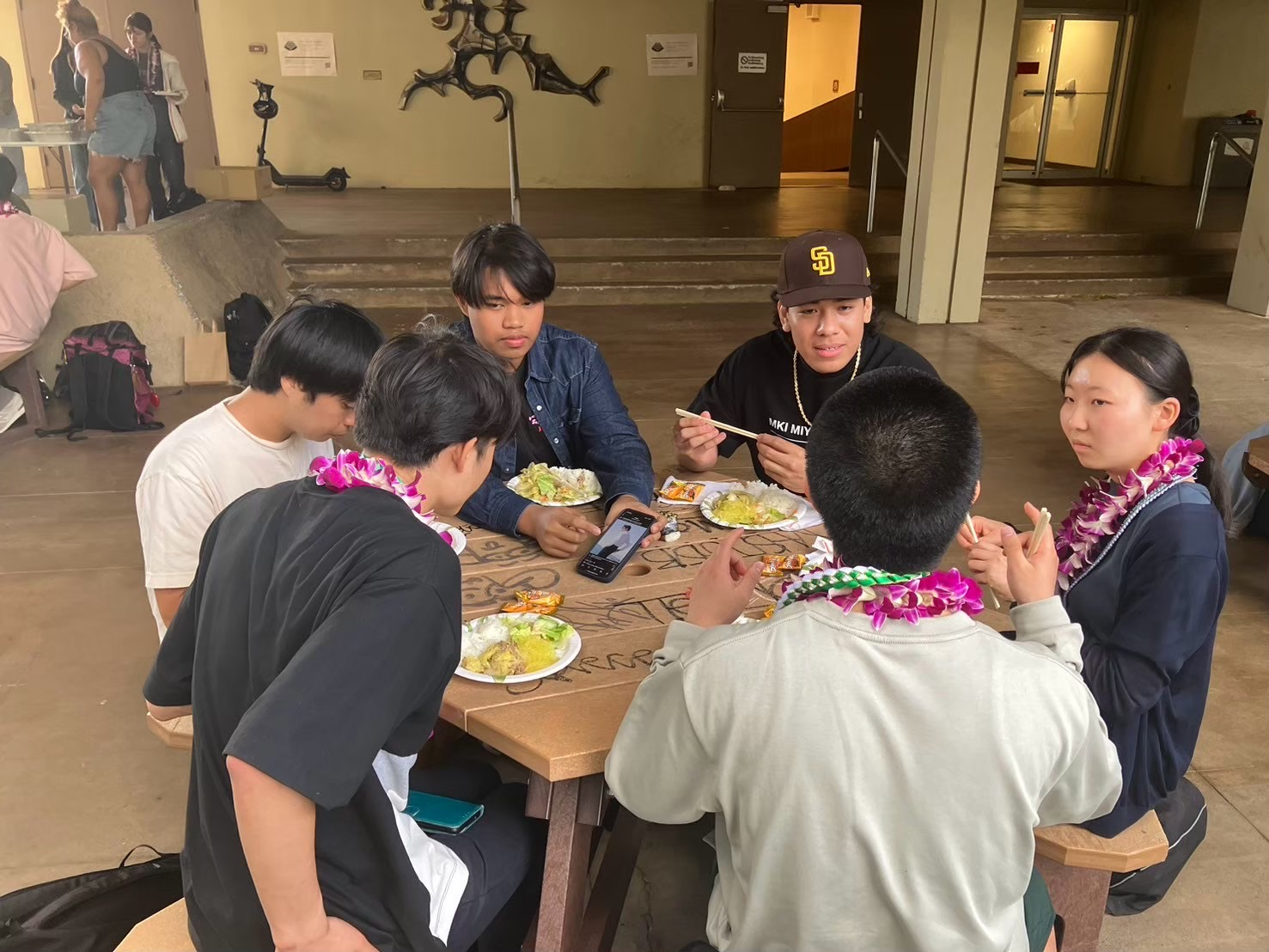
ハワイアンフードを楽しみながら現地学生と交流!
まず3⽉の現地研修をより学び多いものとするために、3度の事前オンライン研修が2⽉に⾏われました。主な活動内容は、UHマノアで日本語を学ぶ学生が主体的に運営しているTadoku
Clubという団体との協働による絵本作りでした。具体的には、英訳できない⽇本語と⽇本語訳ができないハワイ語または英語の意味説明や例⽂を⼀冊の絵本に仕上げる活動でした。
私がオンライン事前研修で最も苦労した点は、⽇本⼈の価値観を表すような⾔葉の⾔語化です。私は「侘び寂び」の意味を伝えようとしました。しかし、⽇本語でさえも説明ができないほど感覚的な概念だったため、しばらく考え込んでしまいました。そして、考えた末思いついた説明は、“Imperfection,
beauty of
imperfection”(不完全さ、不完全さに対する美しさ)でした。すると、現地学⽣になぜ不完全さに美を感じるのかと問われましたが、考えもしなかった質問に私は答えられませんでした。そこで、絵本のデザインを通して感覚的に理解してもらうことを決めました。後⽇、少し雲に隠された三⽇⽉のデザインを現地学⽣に見てもらったところ、綺麗だと⾔ってくれました。私は伝わったことに安⼼すると同時に、⾔葉以外の伝達⽅法の可能性を感じました。英語での会話に不慣れだったこともあり、オンライン事前研修では先述の体験のみならず上手く伝わらない場⾯が何度もありました。そして、その度にジェスチャーや絵といった表現の⼯夫をするようになりました。このような⼯夫は、⽣きた英語で溢れている現地での⽣活で⼤変役立ちました。
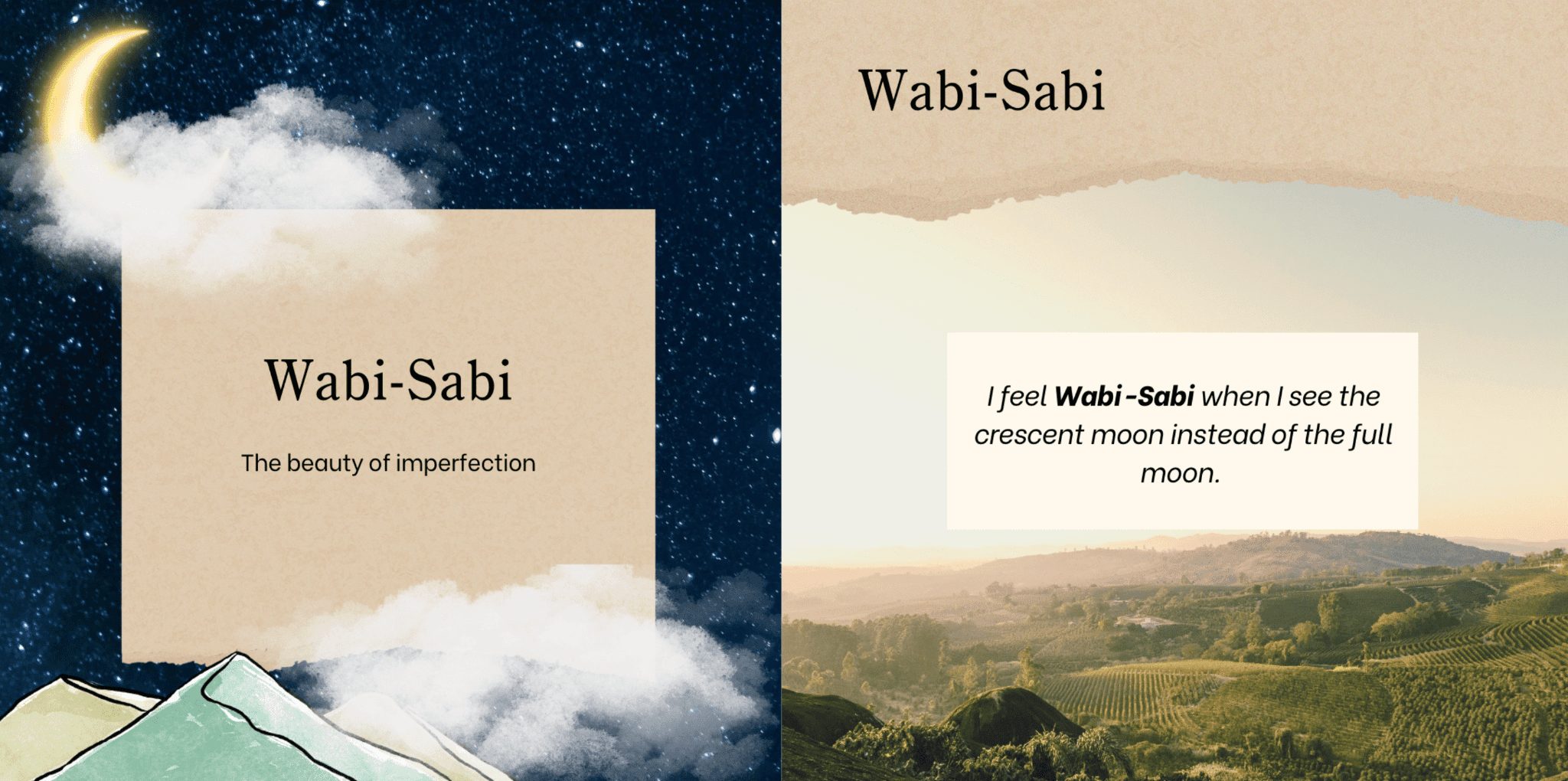
完成した絵本の一部分。
3度のオンライン事前研修を終えると、いよいよハワイ現地研修が⽬前に迫りました。渡航⽇が近づくにつれて、新しい仲間や環境に適応できるか不安が湧いてきました。その⼀⽅で、全てが新しいからこそ、今まで挑戦を嫌ってきた私を変えられるのではないかという期待も抱いていました。そんな中迎えた渡航当⽇、不安は最⾼潮に達しました。しかし、今までオンライン上で会っていた仲間たちと空港で実際に対⾯して時間が経つにつれて、最⾼潮だった不安は消えていきました。そして、ついにハワイへ飛び立ちました。約7時間のフライトを終え、窓の外にはヤシの⽊と照りつける太陽が⾒えました。その瞬間、2週間の研修がついに始まるのだと強く実感しました。⾒慣れない光景に驚きながら空港を出ると、ホームステイファミリーの暖かい出迎えとともにハワイでの研修がスタートしました。午前中は、UHマノアにて、他⼤学の⽇本⼈学⽣とともに、英語での⾃⼰表現⽅法の学習やフラダンスワークショップに参加しました。そして午後には、ハワイの歴史や環境に関するセミナー、フィールドワークに参加したり、Tadoku
ClubやJapanese Culture Clubとの交流をしたりしました。毎⽇が新発⾒の連続で忙しいながらも充実していました。
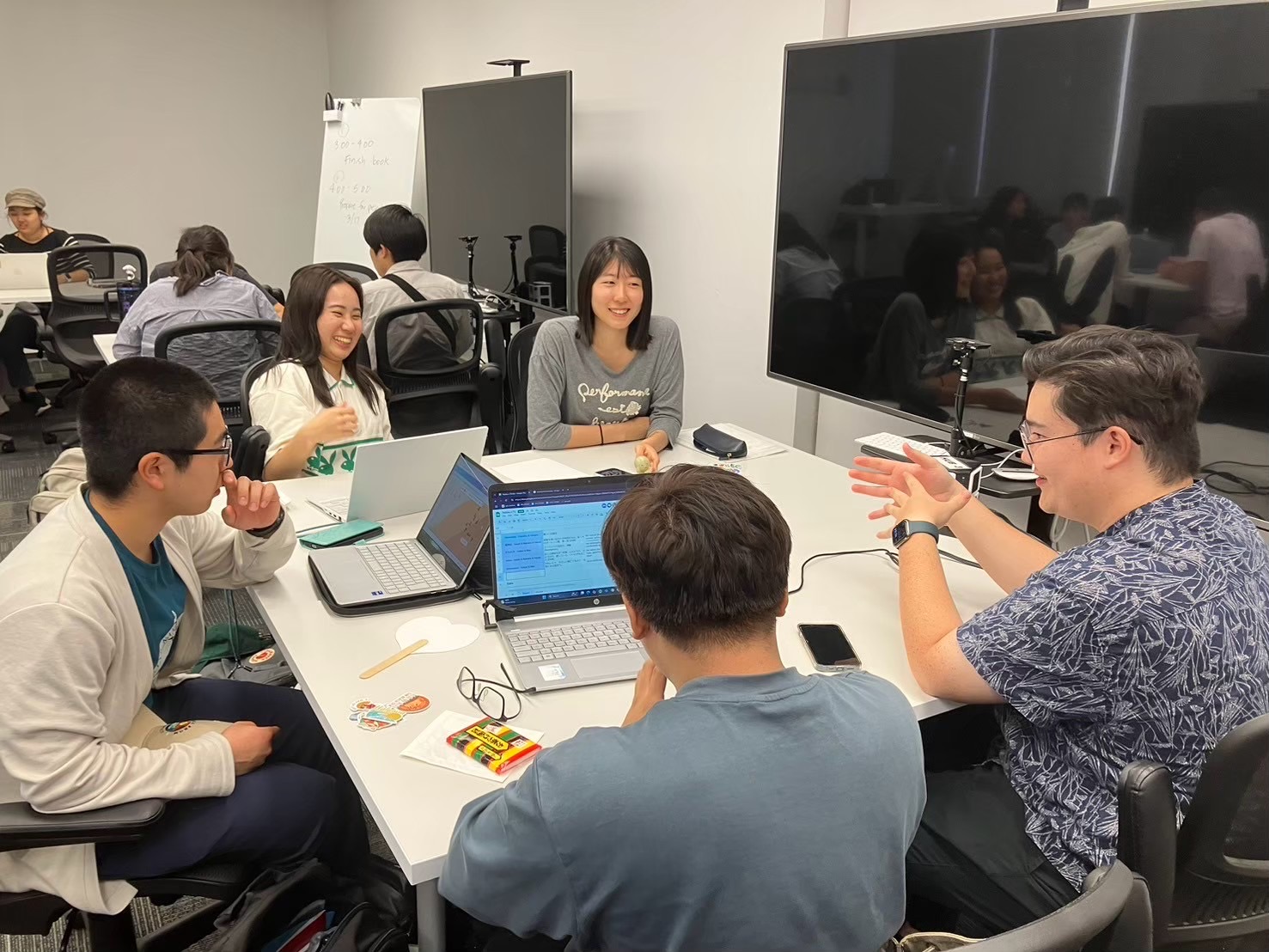
オンライン交流を経て、ついにTadoku Clubと直接顔を合わせ、絵本の最終仕上げに取り組んでいる様子。
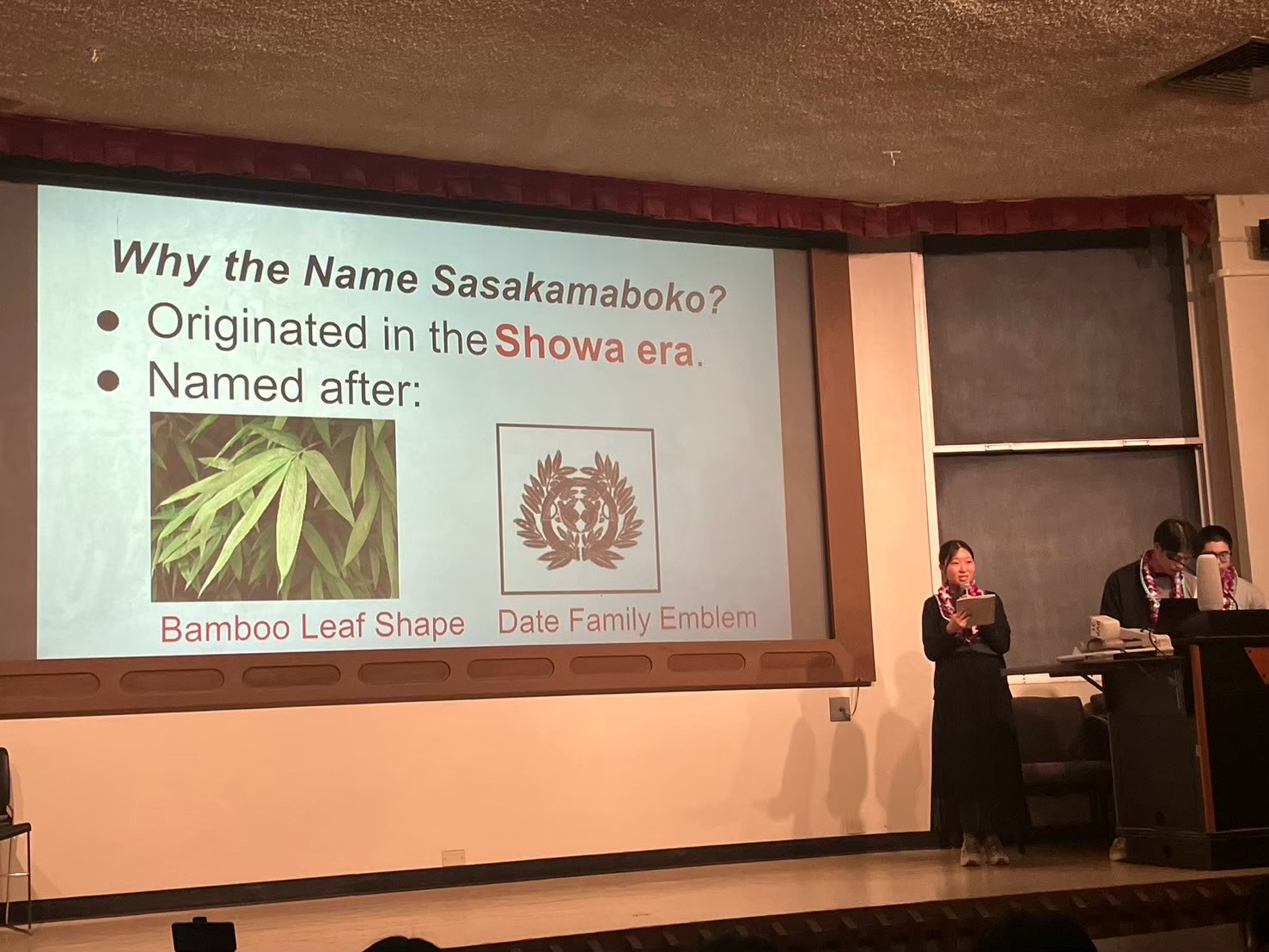
Japanese Culture Clubに向けて、仙台や東北大学の魅力をプレゼン。
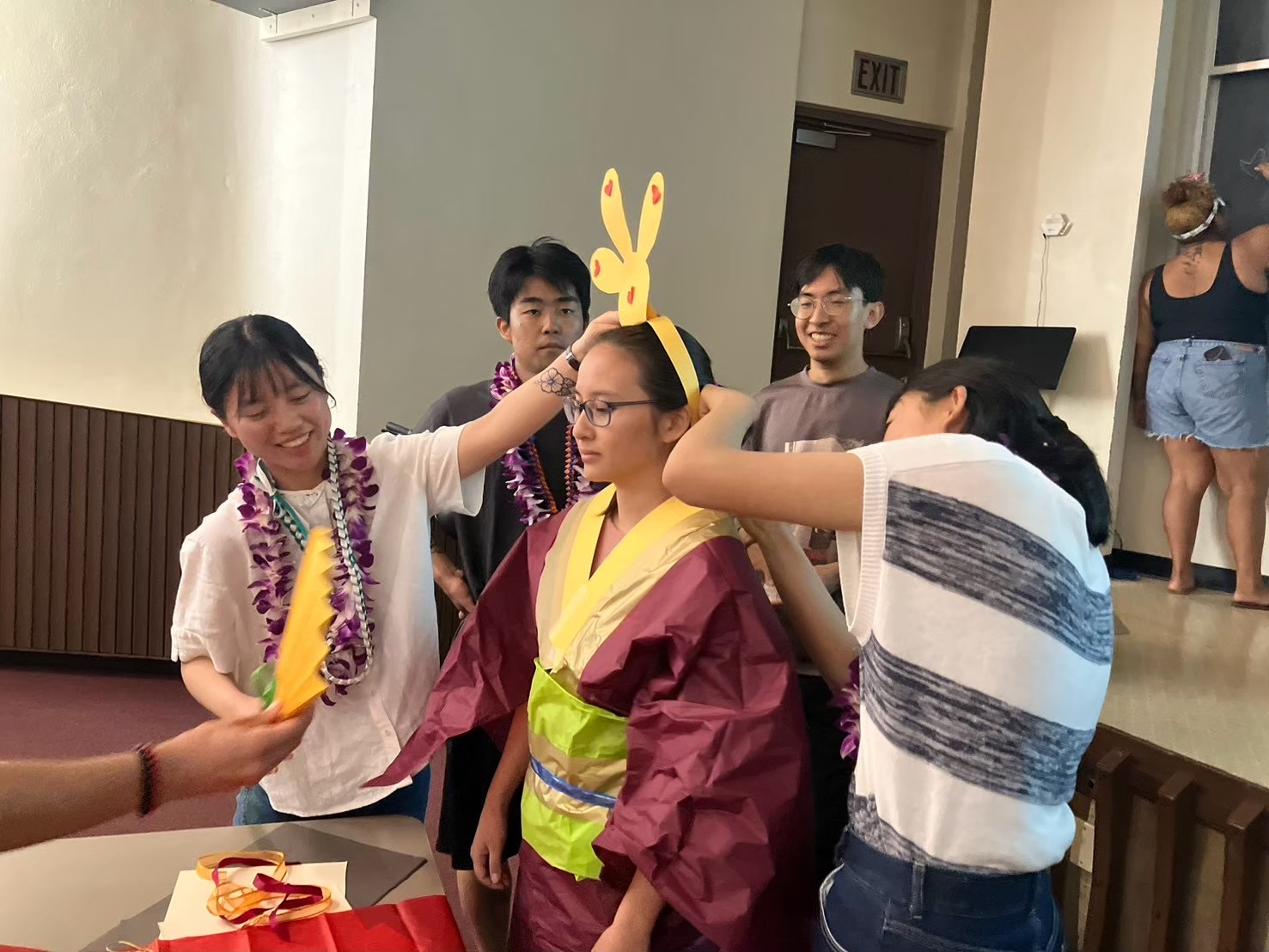
Japanese Culture Clubの現地学生と東北大生が混ざり合ってチームになり、最も豪華で独創的なお雛様・お内裏様のコスチュームを仕上げるのはどのチームかを競い合うゲーム!
その中で特に印象深かった活動は、フラダンスワークショップです。ダンスが苦⼿な私にとって、この授業に⼼配を抱かずにはいられませんでした。しかし、いざ始まってしまうと私の⼼配は不必要だったと気付かされました。なぜなら、フラダンス講師(ハワイ語ではKumu)がフラダンスの動きが持つ意味を丁寧に教えてくださったおかげで、私の考えに変化が起きたからです。フラダンスの動き一つ一つに意味があり、その動きを全てつなげると⼀つの物語になっている。そう思うと、ダンスのうまさは関係なく⾃分の思いが相⼿に伝わればいいのだと考えられるようになりました。そして、最後には他の参加者とともに笑顔で踊ることができました。この経験から、ダンスに限らず⾔葉などの表現において表⾯上のことよりも、伝えたい思いといった内⾯的なことの⽅が⼤切なのだと思うようになりました。すると、拙い英語でもなんとか想いが伝わるようにしようと意識し、英語でも恐れずに会話ができるようになっていきました。
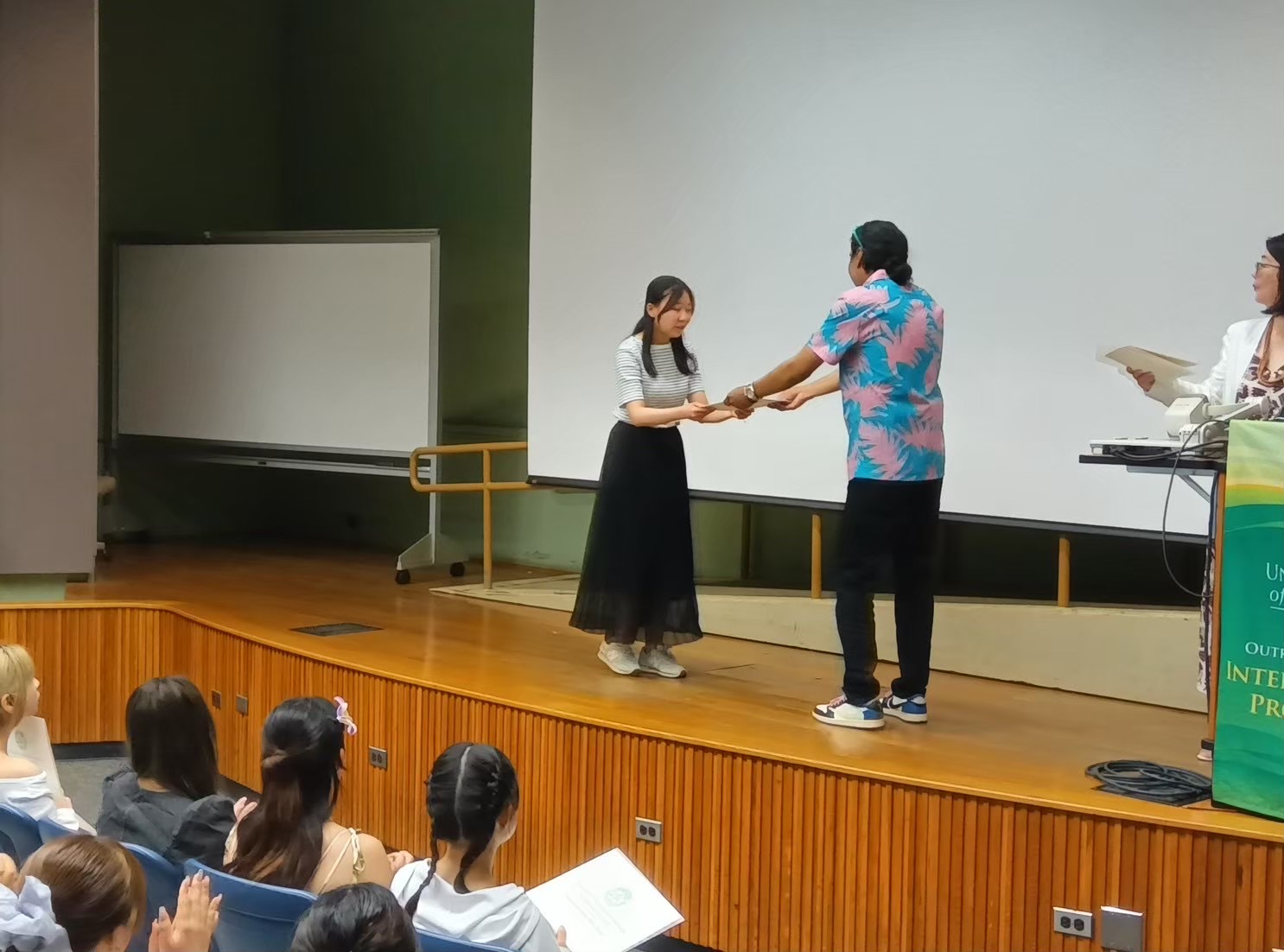
修了式の様子。2週間毎日顔を合わせた英語の先生から修了証を授与された。
ハワイでの現地研修は、2週間とは思えない程あっという間に過ぎていきました。そしてついに帰国の⽇となり、⾶⾏機で眠りに落ちて夢から覚めると、そこは⾒慣れた⾵景の⽇本でした。現地研修が充実していてとても楽しかったからこそ、⽇本到着時に感じた感情は安⼼よりも寂しさでした。あの夢のような2週間に戻れるならば、どれだけ幸せだろうかと幾度も想像しました。しかし、まだ事後報告会が残っていることに気づき、想像から現実へ引き戻されました。事後報告会とは、⼊学前グローバル学習プログラムの全4コースが混ざり合い、互いの研修成果を共有するという会でした。
私にとって事後報告会の発表準備は、⾃分⾃⾝とは全く異なる体験をグループメンバーから聞き、新しい考えを得ることのできる⼤変有意義な時間でした。例えば、私はTadoku
Clubとの活動で、海外と⽇本の価値観の違いを説明することに難しさを感じました。しかしグループメンバーの⼀⼈は、⽇本⼈間でも⼀つの⽇本語について価値観が異なったため、違いを乗り越えて意味説明をすることに難しさを感じたと話していました。この経験を知り、価値観は国ごとに異なるだけでなく、同⼀国内でも個々によっても異なるのだと発⾒しました。このような発⾒は話し合いを進める中で何度もあり、多くの新しい学びを得ることができました。さらに事後報告会の発表準備を通して、仲間と共に⼀つのものを創り上げていく偉⼤さを実感しました。私のグループでは、⼀⼈⼀⼈の個性が溢れていたため、多くの面白いアイデアが出ました。その中から実現可能性や制限時間などを加味しながらアイデアを選び出した結果、発表内に⼨劇と聴衆参加型のフラダンスをすることに決まりました。決定当初は、発表への組み込み⽅や⼨劇の具体的な内容はあまり明確ではありませんでした。そのため、皆が良い発表にしたいという強い気持ちの下、何度も話し合いと練習をして試⾏錯誤を重ねました。
そして迎えた発表当⽇、初めは緊張していましたが、次第に皆で⼒を合わせて作ってきたのだから⼤丈夫と緊張を吹き飛ばす程の⾃信が湧き出てきました。⾃信を持って発表できたおかげで会場の緊張感がほぐれ、聴衆の発表を楽しんでいる雰囲気を感じることができました。努⼒が⾝を結んだ成功だったからこそ、発表後の達成感は⼀⼊でした。実は発表当⽇は、異なるコースが混ざり合うように会場が割り当てられたため、同じハワイコースの他のグループの発表をその場で見ることはできませんでした。しかし、後⽇動画で見ることができました。各グループの動画を見てみると、全グループが個性の発揮された発表を⾏なっていました。例えば、発表中にクイズをしたり実演を行ったり、さらにはハワイの国歌を歌っているグループまでありました。全グループの発表動画において私が⾒つけた共通点は、発表者全員が笑顔だったということです。この笑顔から、発表準備をグループ⼀丸となって取り組んだからこそ生まれた⾃信、研修を通して得た多くの学びに対する喜びが感じられました。
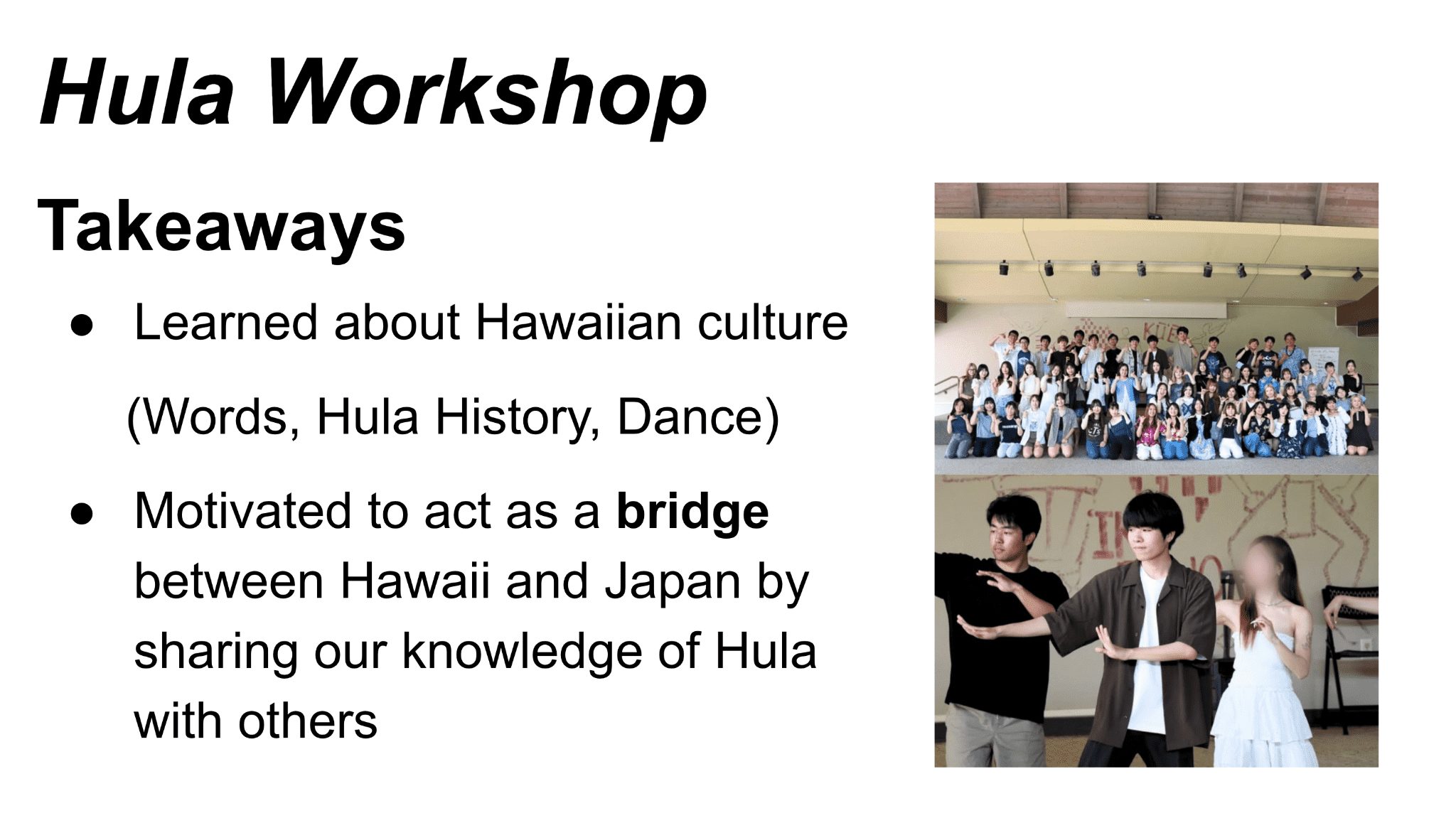
発表資料の一部分。
ここまで読んで、皆さんは、オンライン事前研修から事後報告会までのハワイ研修をどのように感じましたか?最初に皆さんが持っていたゆったりした研修という想像とは異なっているのではないでしょうか。ハワイ研修はもちろんとても楽しかったですが、正直なところ毎⽇が忙しく、⼤変でした。しかし、⼤変だったからこそ学びが多かった上に、今後の⾃分⾃⾝の課題を⾒つけることができたと思います。
さらに、⼤変な毎⽇を頑張ることができたのは、人々との繋がりがあったからだと思います。不慣れな⼟地では迷⼦やバスの乗り間違い、話が伝わりにくいもどかしさ等の困り事が尽きませんでした。そんな中困難にぶつかった時には、⼿を差し伸べて共に乗り越えてくれる⼈がいつも隣にいました。それは、⼀緒に研修に参加した仲間たちや教職員の方々、ホストファミリーや現地学⽣などとの繋がりがあったからこそだと思います。そして、つながりとはいつでも互いに助け合える関係でした。例えば、私が英会話に手こずっている時に仲間がサポートしてくれ、逆に仲間がプレゼンテーション準備で困っている時に私がアドバイスをするという関係でした。このような人々との繋がりは今回の研修に限らず、今後の⼤学⽣活においても重要だと考えています。だからこそ、本研修で出会った仲間たちはもちろんのこと、ハワイの人々との繋がり、そしてこれから出会う新しい人々との繋がりも⼤切にしていきたいと思います。
最後になりますが、⼀緒に研修の最初から最後まで笑い合った仲間たち、研修が実り多いものとなるように⽀えてくださったグローバルラーニングセンターや留学生課の教職員の方々、このような貴重な執筆機会を与えてくださった湊
洵菜先⽣にこの場をお借りして感謝申し上げます。また、長い記事にお付き合いいただいた皆様にも⼤変感謝いたします。ありがとうございました!
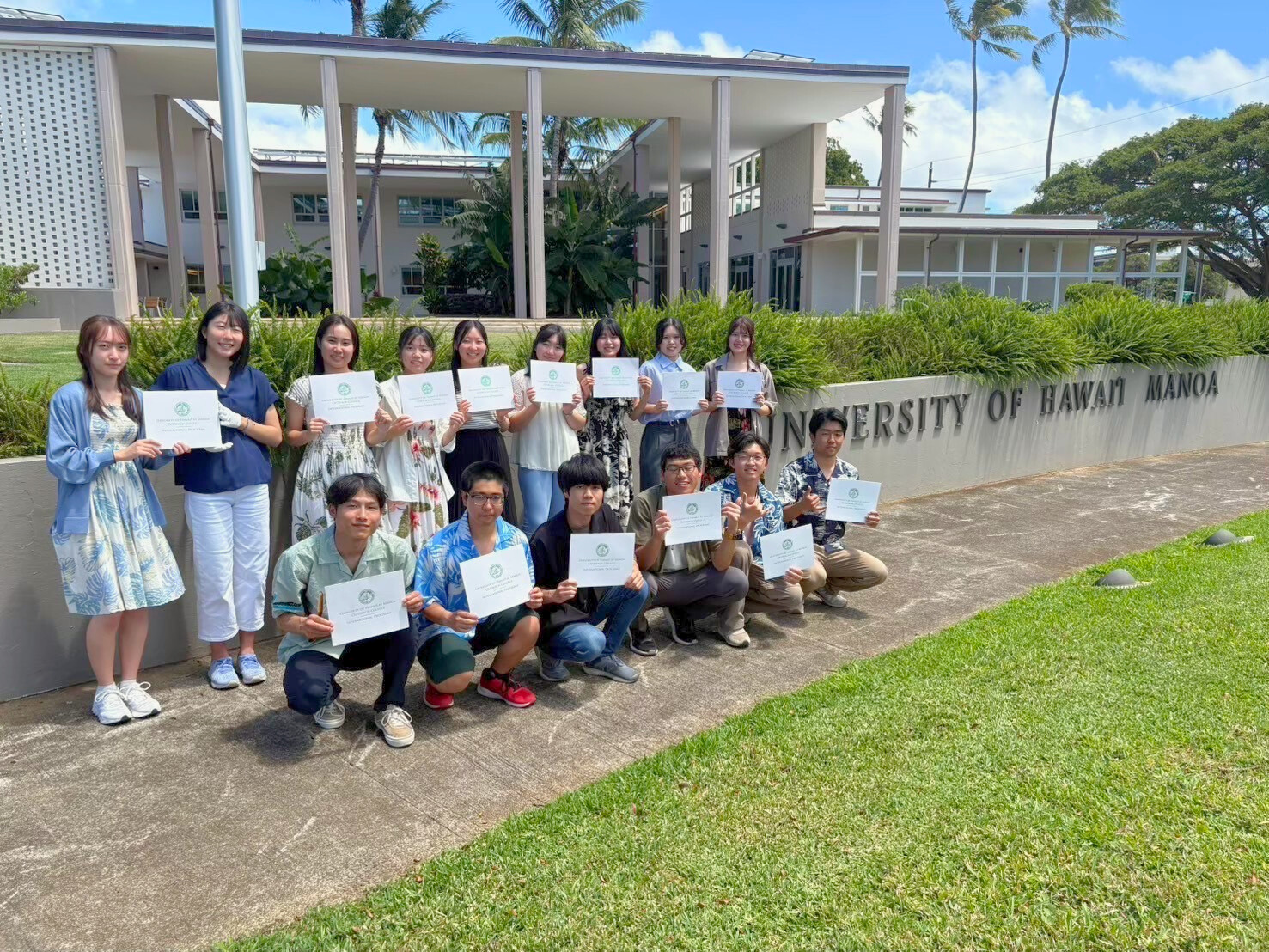

A New World Beyond One Step: Growing Through My Experience in Hawaii
Ayane
Kuroda
First-year student, Faculty of Education, Tohoku University
Tohoku University offers a High School Bridging Program for students who have already been accepted through
holistic admissions. This program provides an opportunity to experience university-level learning and
develop the skills necessary to thrive in a global society. This year, four courses were offered—three at
overseas universities and one at a university in Japan. I participated in the “Environment and Multicultural
Communication Course” in Hawaii. The program consisted of three parts: three online pre-departure
collaborative sessions, a two-week on-site learning program at the University of Hawaiʻi at Mānoa from March
9 to 23, 2025, and a post-program achievement presentation.
By the way, what comes to mind when you hear the word “Hawaii”? Many people probably imagine beautiful
nature and delicious food. You may also think of life in Hawaii, known for its resort-like atmosphere, as
being slow and relaxing. Before you read on, you may already have an image of what my days in Hawaii were
like. If you’re ready, let’s see whether your image of Hawaii is accurate. By the time you finish, it just
might change…

A warm welcome from local students, who greeted us with beautiful handmade lei.

Enjoying Hawaiian food while chatting and connecting with local students!
First of all, the three online pre-departure sessions were held in February. The main activity was creating
a picture book in collaboration with the Tadoku Club, a group of UH Mānoa students learning Japanese. Our
first task was finding Japanese words without English equivalents, and Hawaiian or English words that could
not easily be translated into Japanese. After that, we explained the meanings of these words with example
sentences to each other and compiled them into one book.
The most challenging part for me during this process was verbalizing words that express Japanese values. I
tried to convey the meaning of “Wabi-Sabi.” However, I couldn’t explain it immediately because it’s such an
intuitive and abstract concept—even in Japanese. After much reflection, I came up with the phrase:
“Imperfection, beauty of imperfection.” When I shared this with a fellow local student, he asked me why
imperfection is considered beautiful in Japan. I had never thought about that before, so I couldn’t answer.
Instead of explaining with words, I tried to help him understand through the designs in our picture book. I
drew a crescent moon slightly hidden by clouds. When I showed it to him, he said it was beautiful. I felt
relieved that he understood, and at the same time, I discovered the power of expressing meaning in
alternative ways beyond words.
During the online sessions, I often faced situations like this because I wasn’t used to communicating in
English. Every time I struggled, I tried to come up with new ways to express myself—using gestures,
drawings, and other forms of communication. That creativity helped me navigate daily life surrounded by
natural English in Hawaii.

A portion of the completed picture book.
After the challenging but rewarding online sessions, the on-site learning program in Hawaii finally started.
As the departure date approached, I became more and more anxious about whether I could adapt to the new
environment and people. At the same time, I hoped this new environment would help me overcome my tendency to
avoid trying new things. With those mixed feelings, the departure day arrived, and my anxiety reached its
peak. But after meeting the fellow participants at the airport—whom I had only interacted with online—that
overwhelming anxiety began to ease. And I finally left Japan for Hawaii.
After a seven-hour flight, I looked out the window and saw tall coconut trees and bright sunshine. As soon
as I stepped out of the airport, amazed by the unfamiliar surroundings, the on-site program in Hawaii began
with a warm welcome from my homestay family. During the two weeks, I joined English classes on
self-expression techniques and a hula dance workshop together with Japanese students from other universities
in the mornings. In the evenings, I attended seminars on Hawaiian history and the environment, which were
followed by visits to related sites such as Pearl Harbor National Memorial and Waikiki Beach. I also
interacted with the Tadoku Club and the Japanese Culture Club, which are student-led groups at UH Mānoa.
Each day was packed with activities and experiences—but it was fulfilling.

After online collaboration, we finally met the Tadoku Club members in person and worked together on the final touches of our picture book.

Giving a presentation about Sendai and Tohoku University to the Japanese Culture Club.

Students from UH Mānoa and Tohoku University teamed up for a fun challenge—competing to create the most elaborate and creative Hina doll costumes!
One of the most memorable activities was the hula dance workshop. I couldn’t help but feel nervous, as I’m
not good at dancing. But once the session began, I realized my worries were unnecessary. That was because
the hula dance instructor (called Kumu in Hawaiian) kindly and carefully taught us the meanings behind the
dance. That changed my perspective. By understanding the meaning of each movement, I realized that hula
tells a deep story—and that dancers are trying to express that story. I began to feel that the desire to
express my thoughts to others was more important than dancing well. In the end, I was able to dance the hula
with a big smile, together with the other students. From this experience, I believe that, more than
anything, having the desire to express myself is what lies at the core of any form of self-expression—not
just hula. This realization encouraged me to try sharing what was in my heart with others in everyday
situations, and to communicate in English without fear.

At the closing ceremony, we received certificates from our English instructor, who taught us every day during the two-week program.
The two-week program in Hawaii flew by—it felt like just a moment. Finally, the day to return to Japan
arrived. I fell asleep on the plane, and when I woke up from a dream, the familiar landscape of Japan was
spread out before me. Oddly, I didn’t feel relief. Instead, I felt an emptiness. I kept thinking, “If only I
could go back to those days in Hawaii...” But then I remembered that the post-program presentation session
was still ahead, and that brought me back to the present. The session was held in an inter-course
format—small groups from the four different courses of the Bridging Program mingled and shared their
outcomes with one another.
For me, all the collective efforts my group put into the preparation process were valuable. While reflecting
on our personal experiences and insights together with my group members, I heard stories completely
different from my own and gained new perspectives. For example, I found it difficult to explain the
differences between Japanese and foreign values through my activities with the Tadoku Club. But one of my
group members said that even among Japanese people, perceptions vary greatly—so it was challenging to
interpret meanings while bridging those internal differences. Hearing that, I came to understand that values
are shaped not only by national culture but also by individuals—even within the same country.
Through this presentation, I also experienced the joy of creating something together with others. Each of my
group members had unique strengths, and we came up with many creative and fun ideas. As a result of our
careful selection from the variety, we decided to perform a short play and a hula dance that invited the
audience to join in. At first, we weren’t sure how to structure the performance, but through repeated
meetings and practice, we refined our presentation. On the day of the event, I was nervous at first, but
confidence welled up inside me because I knew we had done our best. I felt that our open and confident
attitude as presenters had a positive effect on audience engagement, making the atmosphere in the venue warm
and cheerful. Our hard work paid off, and the sense of achievement was even greater.
Each group gave their presentations in separate rooms, so unfortunately, I couldn’t watch the other Hawaii
course groups live. However, I had the chance to watch their presentations later on video. Each one
reflected the unique expressiveness of the group—some included quizzes, others gave live demonstrations, and
one even sang the Hawaiian national anthem. From all the presentations, I noticed one thing they had in
common: everyone was smiling beautifully. Their smiles reflected the confidence that comes from working hard
together and the joy of learning deeply through the program.

A slide from our final group achievement presentation.
Now that you’ve read this far, how do you feel about the program? Perhaps your first impression—that the
days in Hawaii would go by slowly—has changed. Of course, it was very exciting, but to be honest, the days
were demanding due to the packed schedule. And yet, that intensity is what allowed me to grow, learn deeply,
and reflect critically and from diverse perspectives on the areas where I can improve in the future.
Most importantly, the connections I made helped me overcome difficulties. Life in an unfamiliar place came
with many challenges—getting lost, taking the wrong bus, or struggling with English. But each time, someone
was there for me, reaching out and working with me to solve the problem. Thanks to the connections and trust
I built with my fellow Tohoku University students, my homestay family, local students in Hawaii, and the
faculty and staff of the international offices at both UH Mānoa and Tohoku University, I was able to
overcome each challenge. In particular, my relationship with fellow students taught me the spirit of mutual
support. For example, they helped me when I had trouble with English, and I gave them advice when they were
struggling with the presentation. These networks will be valuable throughout my university life, and I
believe we can continue encouraging each other beyond this program. I want to cherish the importance of
these bonds—both with those I met through this program and with those I’ll meet in the future.
Lastly, I would like to express my heartfelt gratitude to the fellow members who shared every moment of the
journey with smiles from beginning to end, and to the faculty and staff of the Global Learning Center and
the Student Exchange Division, whose support made the program truly meaningful. I am also deeply thankful to
Ms. Junna Minato for giving me the valuable opportunity to write this article. And finally, thank you for
taking the time to read my story to the end—even though my English may not be perfect. Thank you very much!

